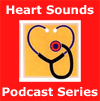
Aortic Valve Ejection Sound (ES)
An ejection sound (ES) is the audible component of achieving peak ejection blood flow velocity. Similar to diastolic filling sounds, it may be the unhappy sound of an unwilling chamber to accept blood, as in the dilated pulmonary artery, pulmonary artery hypertension or truncus arteriosus. More commonly, it is the sound of a dysmorphic semilunar valve caught in the period of maximal ejection from the ventricle with no ability to avoid the flow stream.
The most common ejection sound (ES) is that of a bicuspid aortic valve. Affecting at least one percent of the population, this is a common but often overlooked extra sound. It has the cadence of the fourth heart sound but with some important differences. First, it is most easily heard with the diaphragm of the stethoscope. Second, it occurs after the first heart sound. Therefore, if you are listening to the heart while simultaneously feeling the ipsilateral carotid pulse, the ejection sound (ES) will reach your ears at the same time that the pulse touches your fingers. Meanwhile, the fourth heart sound and first heart sound will be complete and gone by the time the pulse touches your fingers.
If you are having a great deal of trouble differentiating a fourth sound from an ejection sound (ES), use the bell of your stethoscope to listen. With the bell placed lightly over the skin where the sound may be heard best, begin to press more tightly. A fourth heart sound will become less prominent while an ejection sound (ES) will be more easily heard. Accurate recognition of the ejection sound (ES) of a bicuspid aortic valve is important. It is associated with the eventual development of valvular heart disease, and there is also an association between bicuspid aortic valve and aneurysm of the ascending thoracic aorta.
Return to Heart Sounds Podcast Series
Updated March 2009